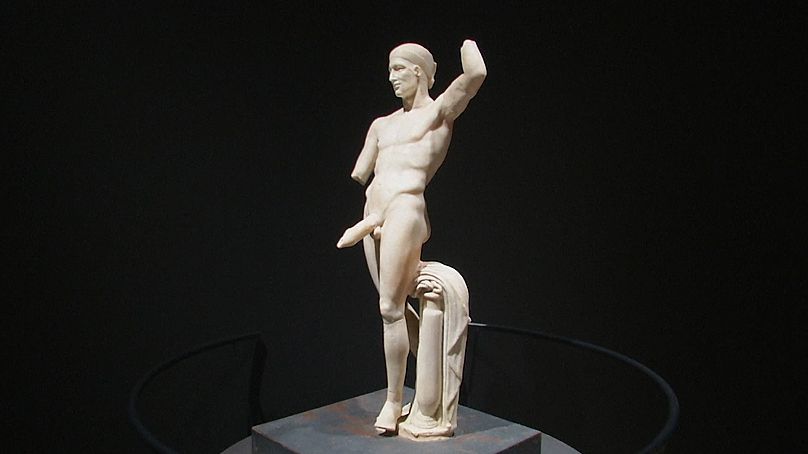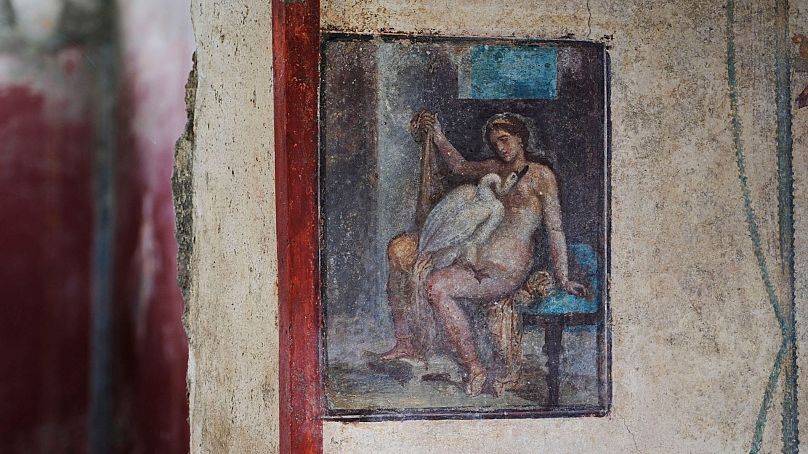If you visit the site Pompeii, you will notice that there is erotic art everywhere you look. A new exhibition titled 'Art and Sensuality in the Houses of Pompeii', aims to look at why the people of Pompeii were so fascinated with eroticism.
It's no wonder the writers of legendary BBC sitcom 'Up Pompeii' decided to set their erotic farce in the famous Italian city. The history of the settlement is steeped in a culture that would make a whole crowd of Frankie Howerds roll their eyes.
And now erotic frescoes and statues recovered from the ashes of Pompeii are being brought together for a new exhibition.
'Art and Sensuality in the Houses of Pompeii', which runs from 21 April to 15 January 2023, showcases the eroticism that characterised virtually every space in the city, from private homes to bathrooms, from taverns to public spaces of the community.
The aim was not to scandalise, but to capture the lofty Greek ideal of the naked body.
What's on display at the exhibition?
Visitors will be able to admire for the first time the majestic ceiling of the cubiculum (bedroom), reassembled and restored, from the House of Leda and the Swan, as well as two bronze medallions with erotic scenes from a ceremonial chariot finely decorated discovered last year.
"We cannot think about Eros and sensuality with the same eyes we look at it today. Its omnipresence is, of course, a sign of it conveying values which are more general than sex rather than… but it conveys values like being culturally elevated, being part of a larger high culture, grace, and knowing how to deal with the world. This is a way to deal with the external world," says Maria Luisa Catoni, Professor of History and Archaeology of Ancient Art and curator of the exhibition.
The show is located under one of the arcades of the great gymnasium. It leads the visitor through a typical Pompeian house, with the works displayed in each room: from the atrium to the cubiculum (bedroom), the triclinium (banquet hall) and the peristyle (colonnaded inner garden).
"Of course, the pieces do not come from one single atrium of a specific house. But we wanted the public to understand the physical connection between what they see here and what they will see around the archaeological parks," explains Catoni.
Exploring Pompeii's obsession with eroticism
The first room upon entering a Roman house was the atrium, a mix between a courtyard and a large reception room.
It was the traditional part of the house, a place of ancestral worship often home to the altar of the Lares Familiares, deities representing the protective spirits of the deceased ancestor.
When Pompeii was destroyed in 79 AD, many of the atriums contained examples of traditional Roman art expressing the social and religious values of the society, but also Greek-inspired works of art, characterised by a new sensuality, such as the first two works of the exhibition: a fresco of Narcissus, the young man in love with his own image, and a sculpture of Priapus, the god of abundance and fertility who often watched over entrances and gardens.
Around the atrium were the "cubiculum" (bedrooms), which were not only used for sleeping. Here people studied, bathed, and retired for private, important or intimate conversations or erotic encounters.
The paintings that decorated the cubiculum often evoke an atmosphere of intimacy, either through idyllic subjects or through openly erotic scenes.
Images of couples during sexual intercourse were found not only in places of prostitution, as in the case of the Lupanare, the brothel of Pompeii, but also in private environments.
The images, rather than reflecting the daily use of the room, were more or less educated references to a literature of an erotic and sexual nature that spread in the Greek world from the third century BC.
Leaving the 'official' part of the house, centred on the atrium, one entered the most intimate space of the peristyle, a porch formed by a row of columns that surrounded the courtyard from which one accessed the triclinium, the room where luxurious banquets were held.
In these rooms, frescoes of boys and girls alluding to heterosexual and homosexual encounters served as a backdrop for conversations and discussions between those at the banquets.
The statue representing the "Ephebe lambadoforo" ("holding the oil lamp") had the dual function of serving as a light source and as a veiled reference to Greek homoeroticism during the symposium. On other occasions, oil lamps decorated with erotic scenes were used.
The exhibition then leads the visitors outside, where a stroll through the ruins of the city reveals various frescoes and works on erotic and sensual themes, allowing the visitor to establish a relationship between what is on display and the finds of the archaeological site.
Whether or not they stumble upon any of Talbot Rothwell's characters, such as Ludicrus Sextus, his promiscuous wife Ammonia, their daughter Erotica and their virginal son Nausius, is perhaps one discovery too many.
Check out the video above for a look inside the steamy exhibition













